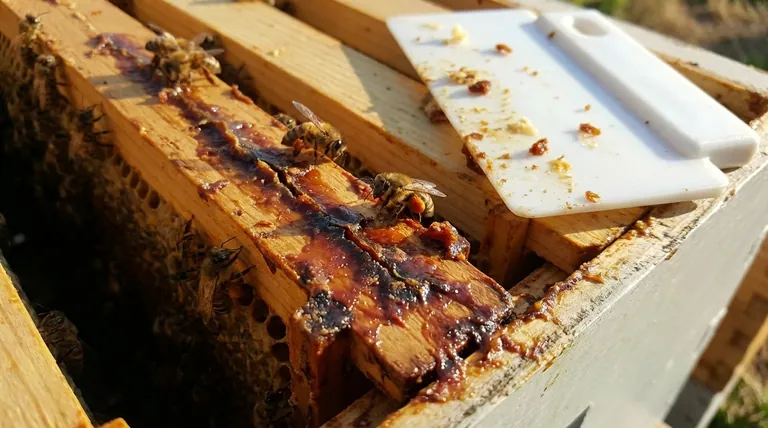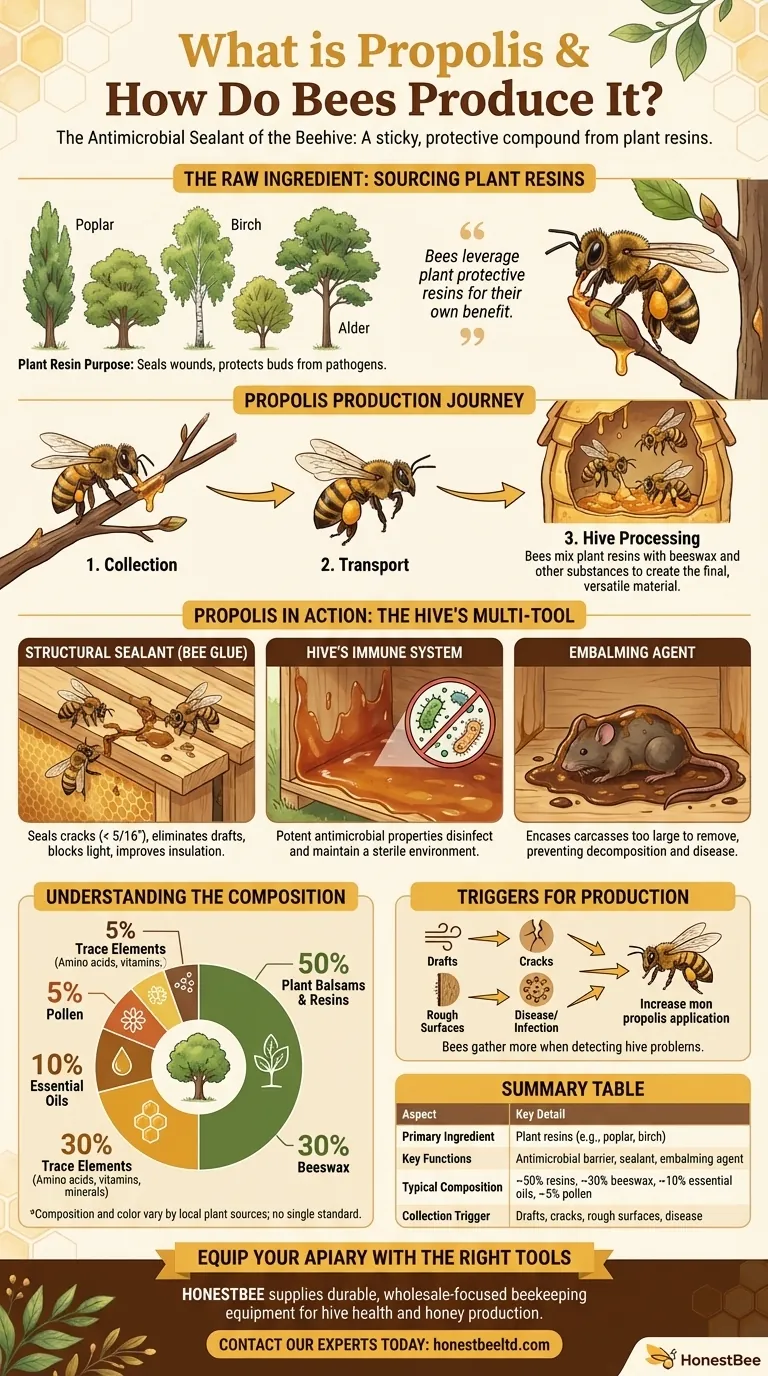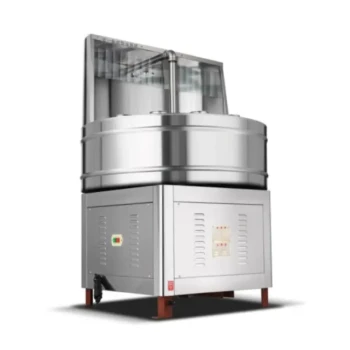Propolis is the antimicrobial sealant of the beehive, a sticky, protective compound that honey bees create from plant resins. Forager bees gather these resins from the buds and bark of trees like poplar and birch, carry them back in their pollen baskets, and mix them with beeswax and other substances to create the final, versatile material.
Propolis is more than just a structural sealant; it is the bee colony's external immune system. Bees strategically collect and use this substance for its powerful antimicrobial properties to sterilize their home and defend against disease.

The Raw Ingredient: Sourcing Plant Resins
The Purpose of Plant Resin
Bees do not create the primary ingredient for propolis from scratch. They source it from plants.
Trees and other plants exude a sticky resin to seal wounds in their bark and protect their buds from fungi, bacteria, and insect attacks. Bees have learned to leverage these natural protective properties for their own benefit.
The Collection Process
Specialized forager bees scrape these sticky resins directly from twigs and leaf buds using their mandibles.
The bee then transfers the sticky substance to the pollen baskets located on its hind legs for transport back to the hive, a process similar to how it carries pollen.
Preferred Plant Sources
The exact source of the resin varies depending on the local environment. Common sources include deciduous trees like poplar, birch, and alder, as well as various conifers.
Propolis in Action: The Hive's Multi-Tool
As a Structural Sealant
Bees use propolis as a general-purpose glue and filler, which is why it's often called "bee glue."
They apply it to seal small cracks and gaps (typically smaller than 5/16th of an inch) to eliminate drafts, block unwanted light, and improve the hive's insulation. Rough surfaces inside the hive also stimulate its application.
As the Hive's Immune System
The most critical function of propolis is disinfection. Its potent antimicrobial properties help maintain a sterile environment inside the hive, protecting the colony from diseases.
Bees use it to line the interior of the hive, effectively creating an antimicrobial barrier that helps keep the colony healthy.
As an Embalming Agent
Occasionally, a pest like a mouse or large beetle may enter the hive and be killed. If the invader is too large for the bees to remove, they will encase the carcass in propolis.
This "embalming" process prevents the body from decomposing and spreading disease throughout the colony.
Understanding the Composition and Trade-offs
The Basic Formula
While its exact makeup varies, propolis generally consists of a consistent blend of core components.
A typical composition is approximately 50% plant balsams and resins, 30% beeswax, 10% essential oils, and 5% pollen. The remainder includes trace amounts of amino acids, vitamins, and minerals.
Why Composition Is Not Standardized
The chemical makeup and color of propolis are entirely dependent on the specific plant sources available to the bees in their local environment.
This means that propolis from one region can have different properties than propolis from another. There is no single universal standard for this natural substance.
Triggers for Production
Bees don't collect propolis resin constantly. They are stimulated to gather more when they detect problems in the hive.
Conditions like drafts, unwanted cracks, rough surfaces, or the presence of a disease infection will trigger an increase in propolis collection and application.
Making Sense of Propolis's Role
Understanding propolis requires seeing it not as a single-use material, but as a strategic, multi-function tool essential for the colony's survival.
- If your primary focus is its structural role: See propolis as the hive's caulk and insulation, used to seal any gap that bees cannot easily pass through.
- If your primary focus is its health role: Recognize propolis as the colony's primary disinfectant, a natural antibiotic that sterilizes surfaces and protects against pathogens.
- If your primary focus is its origin: Remember that propolis is a borrowed defense, leveraging the protective resins that plants produce to heal their own wounds and fight infection.
Ultimately, propolis demonstrates the remarkable ingenuity of honey bees in creating a substance that is simultaneously a building material and a medicine.
Summary Table:
| Aspect | Key Detail |
|---|---|
| Primary Ingredient | Plant resins collected from trees (e.g., poplar, birch) |
| Key Functions | Antimicrobial barrier, structural sealant, embalming agent |
| Typical Composition | ~50% resins, ~30% beeswax, ~10% essential oils, ~5% pollen |
| Collection Trigger | Drafts, cracks, rough surfaces, or disease in the hive |
Equip Your Apiary with the Right Tools
Understanding the critical role of propolis is just the first step. To maintain a healthy, productive colony, you need reliable, high-quality beekeeping equipment. HONESTBEE supplies commercial apiaries and beekeeping equipment distributors with the durable, wholesale-focused supplies needed to support every aspect of hive health and honey production.
Contact our experts today to discuss your specific needs and discover how our product range can help you build a stronger, more resilient operation.
Visual Guide

Related Products
- Professional Wide Blade Honey Scraper for Beekeeping and Honey Processing
- Professional Long-Handled Silicone Honey Scraper for Beekeeping
- Honey Wax Separating Wax Press with Metal Screw Wax Separator Machine
- Stainless Steel Honey Press Wax Press with Tank
- Stainless Steel Pail Perch Bucket Bench
People Also Ask
- Why is my honey frame not capped? Your Guide to Perfectly Ripe Honey
- What equipment do you need to make honey? A Complete Guide to Starting Your Apiary
- What tools are available for uncapping honey? A Guide to Choosing the Right Tool for Your Operation
- What is a multifunction scraper tool in beekeeping? Streamline Hive Inspections with the Ultimate All-in-One Tool
- Why is uncapping necessary in honey harvesting? Unlock Your Honey Yield & Preserve Comb



















